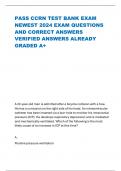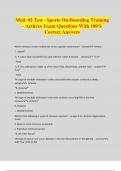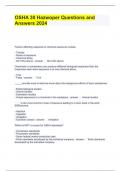Human Resource Management
Chapter 01
Strategic Human Resource Management
True / False Questions
M
1. People are the common element in all social organizations.
E
TRUE
resource management aims to support and enable.
TRUE
D
2. Organizational goals are an organization's short- and long-term outcomes that human
G
3. The field of human resource management is unrelated to key organizational goals, product-
market plans, technology, and innovation.
E
FALSE
E
4. Since human resource management is central to all organizations, all organizations have a
dedicated human resource department.
FALSE
K
5. A new venture or micro-business might initially have the entrepreneur perform HR related
tasks.
TRUE
6. Strategies for businesses are formulated at three levels: corporate, a major business activity,
and employee.
FALSE
1-2
,Human Resource Management
7. Employee salaries may account for more than 65% of the operating expenses in many
organizations.
FALSE
8. Using the focus strategy, a firm concentrates on a segment of the market, competing on the
basis of either differentiation or cost leadership.
TRUE
M
9. Many organizations are now including specific strategies that directly consider their
employees, such as a strategy to become one of Canada's "Top 50 Best Managed
Companies."
TRUE
E
10. Economic boom and bust business cycles are experienced the way same across the
country.
FALSE
D
G
11. Economic forces are defined as economic factors facing Canadian business, including
historical trends, global trade forces, and the force to increase one's own competitiveness and
E
productivity levels.
FALSE
E
12. Canada's international trade advantage is due to its geographical location and multicultural
population.
FALSE
K
13. Companies can gain accreditation in productivity optimization processes through
organizations like the International Association for Six Sigma Certification.
FALSE
1-3
,Human Resource Management
14. Recruiting or developing innovative staff to create a culture of innovation within the
organization is an example of a progressive human resource strategy.
TRUE
15. Firms with nonroutine production processes (such as advertising firms), benefit more from
flexible human resource practices that nurture creativity, innovation, and entrepreneurship
than those that focus on predicting employee performance.
TRUE
M
16. Integrating digital information systems has allowed for more effective knowledge
management.
TRUE
E
17. Primary and extractive industries currently account for most of the national wealth in
Canada.
FALSE
D
G
18. The recent shift in employment from extractive industries to service industries has
increased the need for innovative thinking within organizations.
TRUE
E
19. Moving from a factor-based to a knowledge-based economy is a trend witnessed only in
North America.
E
FALSE
K
20. With an increased reliance on knowledge workers, organizations also start to face
challenges associated with employees hiding and withholding knowledge.
TRUE
21. Educational attainment is the average academic level required to work at a particular job.
FALSE
22. Educational attainment is keeping pace with the growing knowledge-based economy.
FALSE
1-4
, Human Resource Management
23. The set of employability skills identified by the Corporate Council on Education consist of
basic academic skills, personal management skills, and teamwork skills
TRUE
24. The aging population impacts human resource management the same way across all
geographical locations.
FALSE
25. The growing population of youth workers entering the Canadian workforce has
M
implications for Canada on a global scale.
FALSE
E
26. In today's workplace, leaders may be faced with up to five generations of workers-
Generation Z, Generation Y, Generation X, Baby boomers, and Traditionalists.
TRUE
D
27. Cultural forces are challenges facing a firm's decision makers because of cultural
differences among employees or changes in core cultural or social values occurring at the
G
societal level.
TRUE
E
28. Canada continues to be a two-language nation, where the majority of Canadians have
either English or French as their mother tongue.
FALSE
E
29. In the discussion of ethics, there are 3 approaches to determine "Right" behaviour in
ambiguous situations. The 3 approaches are: universalistic, conformist, and subjectivist.
K
FALSE
30. Ethical issues confronting Canadian firms today include issues such as sexual harassment,
cyber espionage, and avoiding conflicts of interest.
TRUE
31. When objectives can be achieved in several acceptable ways, the key to success is
choosing the path that best aligns with individual stakeholder needs.
FALSE
32. HR practices such as seniority- and rank-based pay and top-down communication
channels are likely to work best when organizations consciously make an effort to create an
egalitarian, participative, and entrepreneurial work climate.
FALSE
1-5







